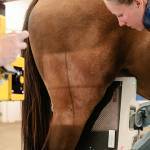Prepurchase and Repository Radiographs in Horses: Points to Ponder

What are repository radiographs?
Repository radiographs are a series of specific radiographs often required when young Thoroughbreds are consigned to public sales. Similarly, in other disciplines, prepurchase examinations are frequently performed, typically including stifles, hocks, and fetlocks, as well as the neck and back, depending on the potential purchaser’s concerns.
Why take prepurchase radiographs?
Regardless of whether they are repository radiographs specific to Thoroughbreds or prepurchase radiographs for horses involved in other disciplines, a veterinarian must interpret the images. Not only must they identify either the presence or absence of lesions, veterinarians must also assign a potential risk for the horse’s future athletic performance.
“If a lesion is present on X-ray, the veterinarian must be able to tell the owner whether he thinks the lesion is likely to affect the horse’s ability to perform the intended work,” explained Kathleen Crandell, Ph.D., a nutritionist for Kentucky Equine Research.
Do interpretation conundrums arise?
How prepurchase radiographs are interpreted can greatly influence the sale of the horse. If the veterinarian interpreting the X-rays assigns a risk rating to the horse, then it may not be sold or trained. Further, one veterinarian may not be concerned about a particular lesion while another may be highly concerned.
Therefore, these prepurchase radiographs potentially have “profound financial ramifications for vendors and prospective owners alike,” said Australian veterinarians who recently conducted a study that investigated agreement between veterinary surgeons when evaluating repository radiographs.
They conducted their study because, while X-ray interpretation is clearly important, data on interobserver agreement for future performance and presence of lesions has not been well studied.
Is there agreement between veterinary interpretations?
The two researchers selected 30 sets of repository radiographs created for Thoroughbred sales yearlings. Three highly experienced equine surgeons were then asked to review the X-rays, noting either the presence or absence of lesions and assigning a risk grade (low, moderate, or high) for future performance. The distal interphalangeal (coffin) joint, metacarpophalangeal and metatarsophalangeal (fetlock) joints, carpus (knee), tarsus (hock), and stifle were assessed.
Here’s what the researchers found:
- There was near perfect agreement for lack of pathology in the fetlock and coffin joints (greater than 98.2%) and very high agreement for the lack of pathology in the carpus, stifle, and fetlock joints (greater than 96%).
- The experts agreed least often regarding lack of pathology in the hock joint.
- When pathology was present, the joint with the highest disagreement was the hock.
- Excellent agreement existed when diagnosing osteoarthritis of the fetlock joints.
- Veterinary surgeons had a high level of agreement when assigning risk for future racing performance in 97% of yearlings. The highest level of disagreement for risk was for the hock as well as the forelimb fetlock joints.
Conclusion
In this study, excellent agreement for both the presence and risk of lesions was identified among the three experienced veterinary surgeons with specialist qualifications. However, there was not complete agreement on risk of lesions affecting future performance.
“The agreement on absence or presence of pathology and risk may further decrease when nonspecialist veterinarians review the radiographs. Further research establishing a standardized reporting and grading scale would be helpful,” Crandell said.
When joint pathology is identified on X-rays, such as osteoarthritis, osteophytes (bone spurs), or osteochondrosis (OCD), even before clinical issues arise, consider offering joint supplements containing glucosamine, chondroitin sulfate, hyaluronic acid, and even omega-3 fatty acids.
“Supplementation with joint-supporting nutrients is commonly used as prophylactic treatment for minimizing the development of joint disease. These ingredients help with maintaining joint integrity, reducing cartilage damage, and stimulating cartilage repair,” Crandell explained.
Additionally, consider supporting bone development with Triacton. This product helps increase bone density in growing and athletic horses. It includes an array of bone-building nutrients, including marine-derived calcium as well as other minerals and vitamins important for bone health.
*Argue, B.J., and B.J. Ahern. Evaluation of agreement for radiographic lesions and risk for racing in thoroughbred yearling sale repository radiographs. Frontiers in Veterinary Science 11:1430993.








